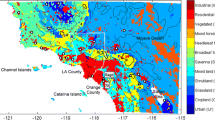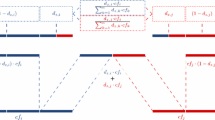Abstract
This study focuses on the relevance of accurate surface parameters, in particular soil moisture, and of parameterizations for heterogeneous land surfaces, for the prediction of sensible and latent heat fluxes by a mesoscale weather forecast model with horizontal grid resolution of 7 km. The analysis is based on model integrations for a 30-day period, which are compared both to flux measurements obtained from the LITFASS-2003 field experiment and to high-resolution-model (1-km grid spacing) results. At first, the relevance of improved parameter sets and input data compared to usual operational practice for an accurate prediction of near-surface fluxes is shown and discussed. It is demonstrated that an observation-based land-surface assimilation scheme leads to an improved soil moisture analysis, which is shown to be essential for the realistic simulation of surface fluxes. Secondly, the implementation of two efficient parameterization strategies for subgrid-scale variability of the surface, the mosaic and the tile approach, is presented. Using these methods, the simulations are in better agreement with measurements than simulations with simple aggregation methods that use effective surface parameters. Integrations with the mosaic approach reproduce high resolution simulations very well and more accurately than simulations with the tile method. Finally, the high resolution simulations are analyzed to justify and discuss the approximations underlying both methods.
Similar content being viewed by others
References
Ament F, Crewell S, Simmer C (2004) Impact of horizontal model resolution on cloud parameters forecasted by a non-hydrostatic mesoscale model. In: Proceedings of 14th international conference on clouds and precipitation –ICCP 2004, Bologna 19–23July, pp 1883–1886
Avissar R, Schmidt T (1998) An evaluation of the scale at which ground-surface heat flux patchiness affects the convective boundary layer using large-eddy simulations. J Atmos Sci 55:2666–2689
Avissar R, Pielke RA (1989) A parameterization of heterogeneous land surfaces for atmospheric models and its impact on regional meteorology. Mon Wea Rev 117:2113–2134
Beyrich F, Mengelkamp H-T et al (2006a) Evaporation over a heterogeneous land surface: EVA_GRIPS and the LITFASS-2003 experiment – an overview. Boundary-Layer Meteorol, this issue
Beyrich F, Leps J-P, Weisensee U, Bange J, Zittel P, Huneke S, Lohse H, Mengelkamp H-T, Foken T, Mauder M, Bernhofer C, Queck R, Meijninger WML, Kohsiek W, Lüdi A, Peters G, Münster H (2006b) Area-averaged surface fluxes over the heterogeneous LITFASS area from measurements, Boundary-Layer Meteorol, this issue
Businger J, Wyngaard J, Iszumi Y, Bradley E (1971) Flux profile relationships in the atmospheric surface layer. J Atmos Sci 28:181–189
Chen F, Avissar R (1994) Impact of land surface moisture variability on local shallow convective cumulus and precipitation in large scale models. J Appl Meteorol 33:1382–1401
Claussen M (1991) Estimation of areally-averaged surface fluxes. Boundary-Layer Meteorol 54:387–410
Davies H (1976) A lateral boundary formulation for multi-level prediction models. Quart J Roy Meteorol Soc 102:405–418
Dickinson R (1984) Modeling evapotranspiration for the three-dimensional global climate models. In: Climate Processes and Climate Sensitivity, Geophysical Monograph, vol 29. Maurice Ewing Volume 5:58–72
Doms G, Schättler U (1999) The nonhydrostatic limited-area model LM (Lokal-Modell) of DWD. Part I: Scientific documentation, available at Deutscher Wetterdienst Postfach 100465, 63004 Offenbach
EEA (2000) Corine land cover (CLC90), European Environment Agency, Copenhagen, http://dataservice.eea.eu.int/dataservice/
Findell KL, Eltahir EAB (1999) Analysis of the pathways relating soil moisture and subsequent rainfall in Illinois. J Geophys Res 104 D24:31565–31574
Giorgi F (1997) An approach for the representation of surface heterogeneity in land surface models. Part I: Theoretical framework. Mon Wea Rev 125:1885–1899
Giorgi F, Avissar R (1997) Representation of heterogeneity effects in earth system modeling: experience from land surface modeling. Rev Geophys 4:413–438
Heinemann G, Kerschgens M (2005) Comparison of methods for area-averaged surface energy fluxes over heterogeneous land surfaces using high-resolution non-hydrostatic simulations. Int J Climatol 25:379–403
Hess R (2001) Assimilation of screen level observations by variational soil moisture analysis. Meteorol Atmos Phys 77(1–4):145–154
Hu Z, Islam S (1998) Effects of subgrid-scale heterogeneity of soil wetness and temperature on grid-scale evaporation and its parameterization. Int J Climatol 18:49–63
Hu Z, Islam S, Jiang L (1999) Approaches for aggregating heterogeneous surface parameters and fluxes for mesoscale and climate models. Boundary-Layer Meteorol 93:313–336
Jacobsen I, Heise E (1982) A new economic method for the computation of the surface temperature in numerical models. Contr Atmos Phys 55:128–141
Klemp J, Wilhemson R (1978) The simulation of three-dimensional convective storm dynamics. J Atmos Sci 35:1070–1096
Koster RD, Suarez MJ (1992) A comparative analysis of two land surface heterogeneity representations. J Climate 5:1379–1390
Lhomme JP, Chehbouni A, Monteny B (1994) Effective parameters of surface-energy balance in heterogeneous landscape. Boundary-Layer Meteorol 71:297–309
Li B, Avissar R (1994) The impact of spatial variability of land-surface characteristics on land-surface heat fluxes. J Climate 7:527–537
Louis J-F (1979) A parametric model of vertical eddy fluxes in the atmosphere. Boundary-Layer Meteorol 17:187–202
Lynn BH, Tao W-K, Wetzel PJ (1998) A study of landscape-generated deep moist convection. Mon Wea Rev 126:928–942
Mahfouf JF (1990) A numerical simulation of the surface-water budget during HAPEX-MOBILHY. Boundary-Layer Meteorol 53:201–222
Mahrt L (1996) The bulk aerodynamic formulation over heterogeneous surfaces. Boundary-Layer Meteorol 78:87–119
Mahrt L, Sun J (1995) Dependence of surface exchange coefficients on averaging scale and grid size. Quart J Roy Meteorol Soc 121:1835–1852
Mauder M, Liebethal C, Göckede M, Leps J-P, Beyrich F, Foken T (2006) Processing and quality control of eddy covariance data during LITFASS-2003. Boundary-Layer Meteorol, this issue
Mellor G, Yamada T (1982) Development of a turbulence closure model for geophysical fluid problems. Rev Geophys Space Phys 20:851–875
Mitchell KE et al (2004) The multi-institution North American land data assimilation system (NLDAS): utilizing multiple GCIP products and partners in a continental distributed hydrological modeling system. Res 109:D07S90, doi:10.1029/2003JD003823.
Mölders N, Raabe A (1996a) Numerical investigation on the influence of subgrid-scale surface heterogeneity on evaporation and cloud processes. J Appl Meteorol 35:782–795
Mölders N, Raabe A, Tetzlaff G (1996b) A comparison of two strategies on land surface heterogeneity used in a mesoscale ß meteorological model. Tellus 48A:733–749
Molod A, Hadyee S, Waugh D (2003) A new look at modelling surface heterogeneity: extending its influence in the vertical. J Hydrometeorol 4:811–825
Ronda RJ, van den Hurk BJJM, Holtslag AAM (2002) Spatial heterogeneity of the soil moisture content and its impact on surface flux densities and near-surface meteorology. J Hydrometeorol 3:556–570
Roy SB, Weaver CP, Nolan DS, Avissar R (2003) A preferred scale for landscape forced mesoscale circulations. J Geophys Res 108:D22, doi:10.1029/2002JD003097
Schlünzen KH, Katzfey JJ (2003) Relevance of sub-grid-scale land use effects for mesoscale models. Tellus 55A:232–246
Segal M, Arritt RW, Clark C, Rabin R, Brown J (1995) Scaling evaluation of the effect of surface characteristics on potential for deep convection over uniform terrain. Mon Wea Rev 123:383–400
Seth A, Giorgi F, Dickinson RE (1994) Simulating fluxes from heterogeneous land surface: explicit subgrid method employing the biosphere-atmosphere transfer scheme (BATS). J Geophys Res 99:18651–18667
Seuffert G, Wilker H, Viterbo P, Drusch M, Mahfouf JF (2004) The usage of screen level parameters and microwave brightness temperature for soil moisture analysis. J Hydrometeorol 5:516–531
Seuffert G, Gross P, Simmer C, Wood EF (2002) The influence of hydrologic modeling on predicted local weather: Two-way coupling of a mesoscale weather prediction model and a land surface hydrology model. J Hydrometerol 3:505–523
Steppeler J, Doms G, Schättler U, Bitzer HW, Gassmann A, Damrath U, Gregoric G (2003) Meso-gamma scale forecast using the non-hydrostatic model LM. Meteorol Atmos Phys 82:75–96
Trier SB, Chen F, Manning KW (2004) A study of convection initiation in a mesoscale model using high-resolution land surface initial conditions. Mon Wea Rev 132(12):2954–2976
USGS (1997) GTOPO30 Digital elevation model, Eros Data Center, US Geological Survey, Sioux Falls, SD. http://edcaac.usgs.gov/gtopo30.asp
Weaver CP, Roy SB, Avissar R (2002) Sensitivity of simulated mesoscale atmospheric circulations resulting from landscape heterogeneity to aspects of model configurations. J Geophys Res 107:D20, doit.: 10.1029/2001JD000376
Author information
Authors and Affiliations
Corresponding author
Rights and permissions
About this article
Cite this article
Ament, F., Simmer, C. Improved Representation of Land-surface Heterogeneity in a Non-hydrostatic Numerical Weather Prediction Model. Boundary-Layer Meteorol 121, 153–174 (2006). https://doi.org/10.1007/s10546-006-9066-4
Received:
Accepted:
Published:
Issue Date:
DOI: https://doi.org/10.1007/s10546-006-9066-4




